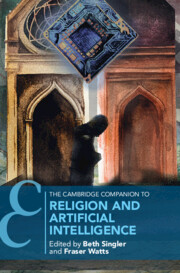Book contents
- The Cambridge Companion to Religion and Artificial Intelligence
- Cambridge Companions to Religion
- The Cambridge Companion to Religion and Artificial Intelligence
- Copyright page
- Contents
- Contributors
- Acknowledgements
- 1 Introduction
- 2 Steps towards Android Intelligence
- Part I Religions and AI
- Part II Social and Moral Issues
- 8 Transhumanism and Transcendence
- 9 The Eschatological Future of Artificial Intelligence
- 10 AI Ethics and Ethical AI
- 11 Black Theology × Artificial Intelligence
- 12 Imag(in)ing Human–Robot Relationships
- Part III Religious Studies
- Bibliography
- Index
- Cambridge Companions to Religion (continued from page ii)
- References
12 - Imag(in)ing Human–Robot Relationships
from Part II - Social and Moral Issues
Published online by Cambridge University Press: 20 November 2024
- The Cambridge Companion to Religion and Artificial Intelligence
- Cambridge Companions to Religion
- The Cambridge Companion to Religion and Artificial Intelligence
- Copyright page
- Contents
- Contributors
- Acknowledgements
- 1 Introduction
- 2 Steps towards Android Intelligence
- Part I Religions and AI
- Part II Social and Moral Issues
- 8 Transhumanism and Transcendence
- 9 The Eschatological Future of Artificial Intelligence
- 10 AI Ethics and Ethical AI
- 11 Black Theology × Artificial Intelligence
- 12 Imag(in)ing Human–Robot Relationships
- Part III Religious Studies
- Bibliography
- Index
- Cambridge Companions to Religion (continued from page ii)
- References
Summary
This chapter addresses some of the scientific, philosophical and theological arguments brought to bear on the debates surrounding human–robot relationships. Noting that we define robots through our relationships with them, it shows how factors such as emotion and agency can indicate things such as a theory of mind that condition users to expect reciprocal relationships that model a sense of partnership. These factors are important in ‘lovotics’, or a trend in social robotics to produce robots that people want to develop relationships with. Such relationships, however, at least given current capabilities in robotics, will always fall short of conditioned expectations because robots, rather than being full partners, are largely reducible to the self or user. The chapter introduces the notions of anthropomorphism and anthropocentrism to demonstrate these critiques, and then moves on to consider alternative figurations of relationships – drawing in particular on articulations of relationality – that may enable us to rethink how we image and imagine robots.
Keywords
- Type
- Chapter
- Information
- The Cambridge Companion to Religion and Artificial Intelligence , pp. 201 - 220Publisher: Cambridge University PressPrint publication year: 2024

